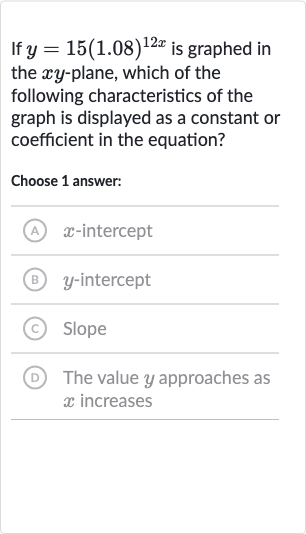AI tutor
Welcome to Bytelearn!
Let’s check out your problem:

If is graphed in the -plane, which of the following characteristics of the graph is displayed as a constant or coefficient in the equation?Choose answer:(A) -intercept(B) -intercept(C) Slope(D) The value approaches as increases
Full solution
Q. If is graphed in the -plane, which of the following characteristics of the graph is displayed as a constant or coefficient in the equation?Choose answer:(A) -intercept(B) -intercept(C) Slope(D) The value approaches as increases
- Identifying Constants and Coefficients: We need to identify which characteristic of the graph is represented by a constant or coefficient in the given equation . Let's analyze the equation.
- Meaning of Constant 'a': The equation is in the form , where , , and are constants. In this case, , , and . We need to determine what each of these constants represents in the graph.
- Meaning of Constant 'b': The constant '' (which is in this equation) represents the initial value of when is . This is because anything raised to the power of is , so when , which simplifies to . Therefore, the constant '' represents the -intercept of the graph.
- Meaning of Constant 'c': The constant '' (which is in this equation) represents the base of the exponential function. It affects the rate of growth or decay of the graph but does not directly represent a characteristic like the -intercept, -intercept, or slope.
- X-Intercept and Exponential Functions: The constant (which is in this equation) is the coefficient of in the exponent. It affects the rate at which the function grows or decays, but like , it does not directly represent a characteristic like the y-intercept, x-intercept, or slope.
- Slope of an Exponential Function: The -intercept is the value of when . Since an exponential function like this one never touches the -axis (assuming b>1, which it is in this case), the -intercept is not represented by any constant or coefficient in the equation.
- Horizontal Asymptote and Exponential Growth: The slope of an exponential function is not constant; it changes at every point on the graph. Therefore, it is not represented by a single constant or coefficient in the equation.
- Horizontal Asymptote and Exponential Growth: The slope of an exponential function is not constant; it changes at every point on the graph. Therefore, it is not represented by a single constant or coefficient in the equation.The value approaches as increases is known as the horizontal asymptote. For exponential growth functions where b>1, approaches infinity as increases, and this behavior is not represented by a specific constant or coefficient in the equation.
